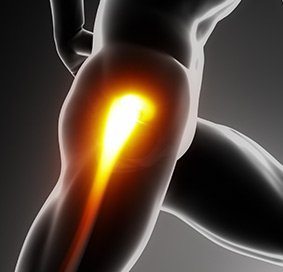X-ray Guided Hip Injections
 The hip joint is a ball and socket joint and is the largest weight-bearing joint in the human body. The head of the thigh bone or femur forms the “ball” and the acetabulum of the pelvis is the “socket”. These bones join together to form the hip joint.
The hip joint is a ball and socket joint and is the largest weight-bearing joint in the human body. The head of the thigh bone or femur forms the “ball” and the acetabulum of the pelvis is the “socket”. These bones join together to form the hip joint.
The hip joint is made up of:
- Bones and joints
- Ligaments
- Muscles and tendons
- Nerves and blood vessels
The hip joint may become painful and inflamed due to various conditions.
Hip joint injections can help diagnose the source of pain as well as alleviate the discomfort. A hip joint injection is a mixture of an anesthetic which blocks pain impulses and a steroid which reduces inflammation to the area. Hip joint injections are a conservative treatment approach to relieve hip pain.
Disease Overview
The hip joint helps to bear your body's weight while standing, walking and running. The joint may become painful and inflamed due to overuse, trauma or certain medical conditions such as osteoarthritis, leading to pain in the hip, low back, buttock or leg. The pain may increase with certain activities and movements.
Indications
Hip joint injections are usually indicated to treat hip joint pain not relieved by other conservative treatment options. Conditions treated with hip joint injections include:
- Arthritis (inflammation of the joints)
- Bursitis (inflammation of fluid-filled sacs that act as a cushion between bones and soft tissue present in the joint)
- Synovitis (inflammation of the joint lining)
- Defects of the hip labrum (the raised rim of cartilage that borders the lining of the acetabulum)
- Trauma or post-surgical pain
Surgical procedure
Hip joint injection is performed with the patient sedated lying face up on an X-ray table.
- The injection site is identified on your hip with the help of live X-ray guidance.
- The skin over this site is cleansed and covered with sterile drapes. An anesthetic injection is administered to numb the skin.
- A needle is guided into the hip joint with the help of live X-ray imaging and a dye is instilled to confirm its position.
An injection of anesthetic and steroid medicine is then administered.
- Once completed, the needle is removed and the injection site covered with a small dressing. You are then taken to the recovery room.
- You are observed for about 15 minutes following the procedure and once stable are discharged to home.
- The entire procedure takes approximately 30 to 60 minutes.
Post-Operative Care
Your doctor will prescribe medication and ice pack applications to help relieve any pain and soreness at the injection site.
You are advised not to drive, bathe or shower immediately after the procedure. The anesthetic in the injection usually has an immediate effect. The steroid component will start to show effects in 2-3 days.
Risks and complications
Risks and complications with this procedure are rare and include
- Bruising at the injection site
- Allergic reaction
- Infection
- Leg problems or weakness












